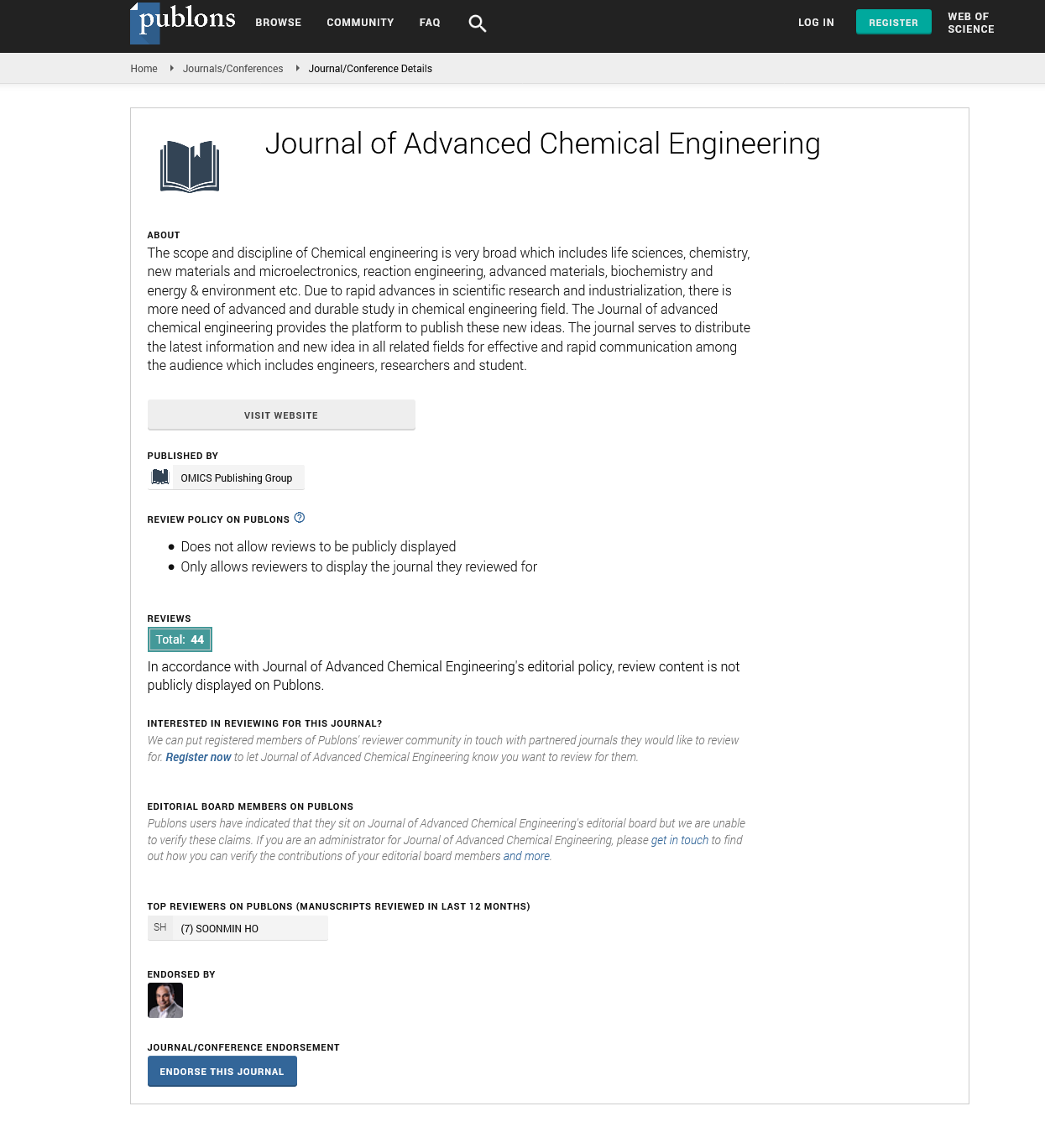Indexed In
- Open J Gate
- Genamics JournalSeek
- Smithers Rapra
- RefSeek
- Directory of Research Journal Indexing (DRJI)
- Hamdard University
- EBSCO A-Z
- OCLC- WorldCat
- Scholarsteer
- Publons
- Geneva Foundation for Medical Education and Research
- Google Scholar
Useful Links
Share This Page
Journal Flyer

Open Access Journals
- Agri and Aquaculture
- Biochemistry
- Bioinformatics & Systems Biology
- Business & Management
- Chemistry
- Clinical Sciences
- Engineering
- Food & Nutrition
- General Science
- Genetics & Molecular Biology
- Immunology & Microbiology
- Medical Sciences
- Neuroscience & Psychology
- Nursing & Health Care
- Pharmaceutical Sciences
Commentary - (2022) Volume 12, Issue 12
Prediction of Absolute Chemical Reaction Rate by using Rate Constant Equation
John Peter*Received: 02-Dec-2022, Manuscript No. ACE-22-19353; Editor assigned: 07-Dec-2022, Pre QC No. ACE-22-19353 (PQ); Reviewed: 21-Dec-2022, QC No. ACE-22-19353; Revised: 26-Dec-2022, Manuscript No. ACE-22-19353 (R); Published: 04-Jan-2023, DOI: 10.35248/2090-4568.22.12.261
Description
The formula for calculating absolute reaction rates uses quantities that are now available from potential surfaces that can be built. Ordinary statistical mechanics is used to calculate the probability of the active state. The precise rate of response is determined by multiplying this probability by the rate of decomposition. The relative reaction rates for isotopes are substantially different from the rates predicted by simple kinetic theory due to the appearance of quantized vibrations in the activated complex in degrees of freedom that are unquantized in the original molecules. The prerequisites for the reduction of the broad statistical treatment to the customary kinetic therapy are provided.
According to a widely-held belief among chemists, chemical reactions that take place in the gas phase have rate constants that depend on temperature in the following way: k(T)=exp (- E,/ RT), where the activation energy, Ea, can be roughly related to the reaction's barrier height on the potential energy surface. Most people are unaware that there are numerous straightforward reactions of broad contemporary significance that do not have rate constants in this form and, in fact, have rate constants whose magnitude decreases as temperature rises.
It has been challenging to quantify these reactions' rate constants accurately because they frequently involve extremely reactive species like free radicals and ions. These reactions can have rate constants that are orders of magnitude greater than those found for reactions with activation energies.
Additionally, the rate constants can exhibit intriguing temperature variations that can be challenging to quantify, particularly at low temperatures. However, some of these challenges are being addressed as a result of considerable technological advancements, and a wealth of experimental data on the rates of fast chemical processes that appear to have zero or negative activation energies is now being produced.
Experiments demonstrate how the irradiation of one or more laser beams during individual bimolecular collisions or during unimolecular decompositions can be used to influence the product routes. Control of reagent approach geometry, orbital alignment, and selective activation of reagent vibrational modes have all been used to prevent bimolecular collisions. Control of unimolecular reactions has been accomplished by varying the temporal shape and spectral composition of ultrashort, chirped radiation pulses as well as by quantum interference between several reaction routes connecting the identical initial and final states. The comprehension of how chemical reactions take place is greatly enhanced by these collision-control studies.
The creation of micro fabricated devices for use in the chemical and biological sciences has advanced significantly in recent years. The requirement to conduct quick measurements on small sample amounts has sparked a great deal of progress. On a more fundamental level, though, the ability to better control and utilise physical processes when instrument dimensions are shrunk to the micrometre range has sparked interest in tiny analytical systems. These systems outline new operating paradigms and forecast the potential revolution in chemical production and high-throughput synthesis that molecular synthesis may bring about.
The theory and applications of organic chemistry depend on the ability to anticipate the outcome of arbitrary chemical processes. Three poles, or approaches, can be used to categorise methods for solving the reaction prediction problems: (1) physical laws; (2) rule-based expert systems; and (3) inductive machine learning. Previous methods at these poles, respectively, lack the data and structure necessary for implementation, are not high throughput, and are not generalizable or scalable. We suggest a fresh method for anticipating reactions that draws on components from each pole.
Conclusion
Using a conceptualization that is physically inspired, we define single mechanistic processes as interactions between coarse Molecular Orbital (MO) approximations and employ topological and physicochemical characteristics as descriptors. We create a constrained chemistry data set from an existing rule-based system (Reaction Explorer) that includes 1630 complete multistep reactions with 2358 unique starting materials and intermediates, associated with 2989 productive mechanistic steps and 6.14 million fruitless mechanistic steps. Additionally, using machine learning, we formulate the task of identifying useful mechanistic steps as a statistical ranking, information retrieval problem. Given a set of reactants and a description of the conditions, we must learn a ranking model over potential filled-to-unfilled MO interactions such that the highest-ranked mechanistic steps produce the main products. We initially train atom level reactivity filters to remove 94.00% of unproductive reactions with a 0.01% error rate as part of the machine learning implementation.
Citation: Peter J (2023) Prediction of Absolute Chemical Reaction Rate by using Rate Constant Equation. Adv Chem Eng.12:261.
Copyright: © 2023 Peter J. This is an open-access article distributed under the terms of the Creative Commons Attribution License, which permits unrestricted use, distribution, and reproduction in any medium, provided the original author and source are credited.

